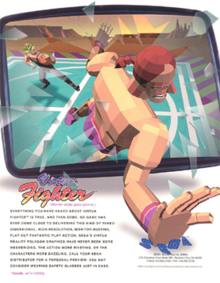
Back فيرتشوا فايتر Arabic فيرتشوا فايتر ARZ Virtua Fighter Catalan Virtua Fighter German Virtua Fighter Spanish Virtua Fighter (bideo-jokoa) Basque ورچوئا فایتر (بازی ویدئویی) Persian Virtua Fighter Finnish Virtua Fighter (jeu vidéo) French Virtua Fighter Italian
| Virtua Fighter | |
|---|---|
 North American arcade flyer | |
| Developer(s) | Sega AM2 |
| Publisher(s) | Sega |
| Director(s) | Yu Suzuki |
| Producer(s) | Yu Suzuki |
| Designer(s) | Seiichi Ishii |
| Programmer(s) | Toru Ikebuchi |
| Composer(s) | Takayuki Nakamura |
| Series | Virtua Fighter |
| Platform(s) | Arcade, Saturn, 32X, R-Zone, Windows |
| Release | Arcade Saturn Arcade (Remix) Saturn (Remix) 32X Windows 95 (Remix) |
| Genre(s) | Fighting |
| Mode(s) | Single-player, multiplayer |
| Arcade system | Model 1, ST-V (Remix) |
Virtua Fighter[a] is a fighting game developed and published by Sega for arcades. It was developed for the Sega Model 1 arcade platform by AM2, a development group within Sega headed by Yu Suzuki. An early prototype version was location tested in Japan by August 1993, before the complete game was released worldwide in December 1993.[4] It was the first arcade fighting game to feature fully 3D polygon graphics. The game was ported to Sega Saturn as a global launch title in 1994 and 1995, and also received a port to the Sega 32X.
The game was critically acclaimed and a major hit, becoming one of Sega's best-selling arcade games of all time with more than 40,000 arcade units sold while the Saturn versions sold over 1 million copies. Virtua Fighter was highly regarded for its in-depth 3D fighting engine and real-world fighting techniques, and has been revolutionary and highly influential in the evolution of the genre and video games in general.[5][6] Its success led to the Virtua Fighter series, with its sequel Virtua Fighter 2 released in 1994.
In 1995, an update titled Virtua Fighter Remix was developed and released by AM1,[7] featuring drastic graphical improvements.[8] This improved version was quickly ported to the Saturn console[9] and later also received a port to Microsoft Windows. The game's remake, Virtua Fighter 10th Anniversary, was released for the PlayStation 2 in 2003 as a stand-alone title in Japan and as a bonus to Virtua Fighter 4: Evolution in North America.
- ^ a b Akagi, Masumi (October 13, 2006). アーケードTVゲームリスト国内•海外編(1971–2005) [Arcade TV Game List: Domestic • Overseas Edition (1971–2005)] (in Japanese). Japan: Amusement News Agency. pp. 131–3. ISBN 978-4990251215.
- ^ "Megadrive Review: Virtua Racing". Mean Machines. No. 19. pp. 48–50. Retrieved July 24, 2015.
- ^ "格闘ゲーム歴史年表 アーケード版 (仮)".
- ^ "バーチャファイター – 株式会社セガ". セガ・アーケードゲームヒストリー|株式会社セガ (in Japanese). Retrieved October 29, 2023.
- ^ Cite error: The named reference
NG11was invoked but never defined (see the help page). - ^ Cite error: The named reference
1UPwas invoked but never defined (see the help page). - ^ "Preview: Die Hard Arcade". Sega Saturn Magazine. No. 16. Emap International Limited. February 1997. p. 24.
- ^ Cite error: The named reference
:0was invoked but never defined (see the help page). - ^ "Virtua Fighter Remix". Next Generation. No. 12. Imagine Media. December 1995. p. 209.
Cite error: There are <ref group=lower-alpha> tags or {{efn}} templates on this page, but the references will not show without a {{reflist|group=lower-alpha}} template or {{notelist}} template (see the help page).